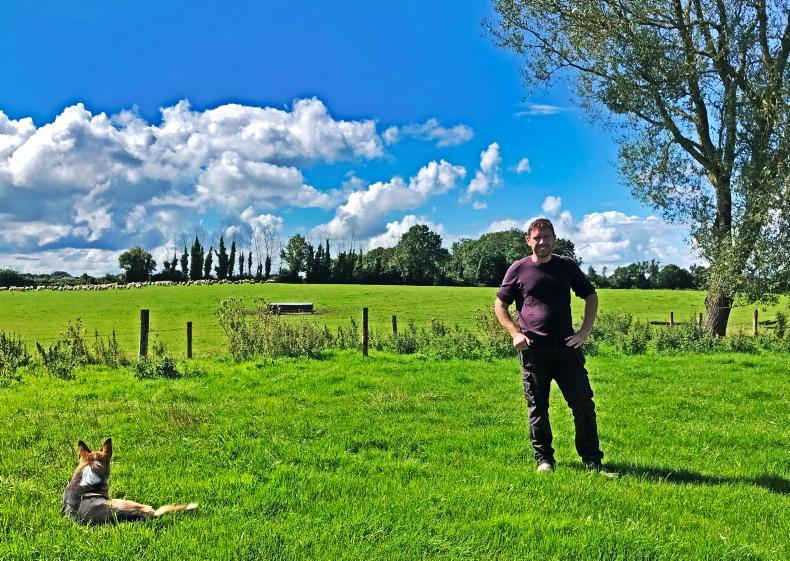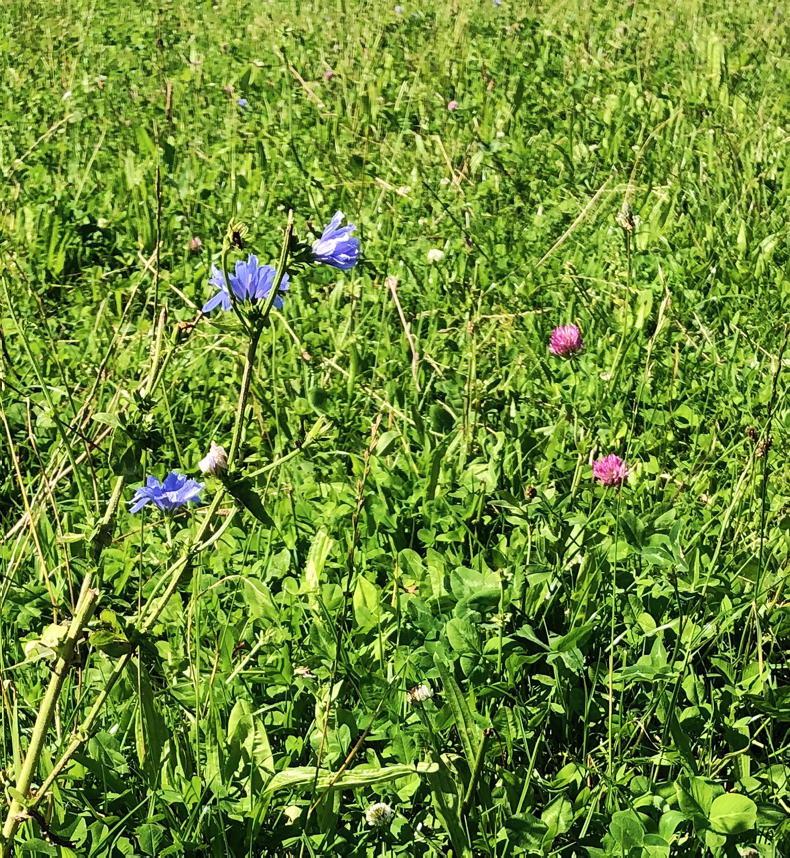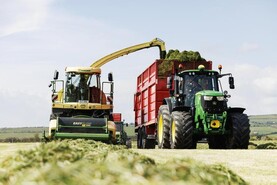During a recent visit to Tullamore Farm, the Irish Farmers Journal demonstration farm in Co Offaly, I had the opportunity to catch up with farm manager Shaun Diver.
We discussed how he has been implementing two of the key pillars of the strategic vision for the 180ac mixed drystock farm, namely, “striving for sustainability” and “building biodiversity”.
Like many farmers, Shaun enjoys sharing the farm with wildlife. He fondly recalls hearing the chorus of corncrakes and curlews while growing up on the family sheep farm in Inishowen, Co Donegal.
Likewise, he was pleased to report that both buzzards and barn owls have been spotted in the skies above Tullamore Farm in recent years. However, he also admits that there is much that can still be done around the farm to increase sustainability and boost biodiversity.
Experimenting with
multispecies swards
One area where Shaun has achieved particular success this year is in the utilisation of multispecies swards.
In May 2022, Shaun experimented by sowing a 2.2ha paddock with a multispecies sward mix.
His mix included red clover, white clover, timothy, perennial rye grass (PRG), chicory and plantain. Notably, the sward received no chemical nitrogen.
Shaun reported that despite the dry conditions in May last year, the sward established well; the only issue he faced was growth becoming too strong to keep up with at times.
This year, he grazed the multispecies sward at 2,500kg DM/ha, although he admitted he would have preferred to “go in at 1,700-1,800kgDM/ha”.
Shaun said “the advice is to go in a little heavier than PRG and come out a little earlier”.

Shaun Diver, farm manager at Tullamore Farm, is committed to learning more about how to promote biodiversity on the 180 acre mixed drystock holding.
Nevertheless, he observed good regrowth even after grazing to 4cm, though he acknowledged that grazing to this height might impact the persistence of some species in the sward and said that he will aim for 5-6cm in future.
Multispecies swards can reduce
the carbon footprint of beef
Recent research conducted at UCD, using the same mix of six species that Shaun used on Tullamore Farm, has shown that not only do multispecies swards require 60% less nitrogen fertiliser when compared to other swards, but that they can also produce up to 25% more herbage for cattle.
Furthermore, animals grazing these swards were shown to have reached their target weights five to six weeks earlier than those on PRG swards.
This result translates to a 15% reduction in the carbon footprint of beef produced off multispecies swards.
Growing body of evidence
This research contributes to the growing body of evidence supporting the idea that multispecies swards can effectively reduce farm inputs, enhance farm sustainability and improve animal performance.

A six-species multispecies sward mix on a 2.2 ha field at Tullamore Farm, with chicory (left) and red clover (right) in flower.
In terms of Shaun’s experience, he emphasised that even if both the chicory and the plantain are lost from the sward after a few years, their long tap roots will have enriched the soil and improved drainage, providing long-term benefits to the grazing land.
All things considered, Shaun is confident that this year’s experiment with multispecies swards at Tullamore Farm was a resounding success.
Plantain has a long taproot, making it a good drought-resistant and soil conditioning addition to multispecies swards. Recent research has also shown that plantain can lead to reduced nitrogen leaching by lowering the concentration of N in cows’ urine.Birdsfoot trefoil is a protein-rich nitrogen fixer, a natural anthelmintic and has been linked to reduced methane emissions in dairy cows.Vetch and hairy vetch fix nitrogen and are high in protein.Sainfoin, translated from French as “healthy hay”, is a deep-rooting nitrogen fixer, a natural anthelmintic and produces a high yield with little or no fertiliser required.Salad burnet has a long taproot that lifts trace elements from deep within the soil, making them available to both grazing livestock and (through dung and decaying plant material) to grasses with shallower rooting systems. Sheep’s parsley is high in iron and vitamins A and C and has been linked with enhanced fertility in breeding stock.Yarrow has been linked with improved circulation and blood flow in livestock.Species: when deciding on your mix, do some research into the persistency and grazing preferences of the various species. Chicory, for example, really comes into its own in its second year, while salad burnet is a strong perennial once established, but can disappear if heavily grazed during its establishment phase.Sowing: shallow sowing and good seed-to-soil contact is key to germination. It is possible to undersow into a cereal crop to provide a cash crop while the ley develops. Over-seeding is also an option but every farm is different; it’s important to do some research and to seek advice to maximise your chances of success.Persistence: research suggests that it takes four years for the root system to provide the full range of associated benefits in terms of soil health. Swards can be productive for much longer, however, so it’s not always necessary to reseed after four years, although species diversity may begin to drop off.Grazing: rotational (or mob) grazing with back-fencing works well with multispecies swards – continuous or tight grazing can cause a drop off in species diversity.Visit (https://www.farmersjournal.ie/footprint-farmers-mine-minerals-with-multispecies-swards-774648 to read more about success with multispecies swards on Footprint Farms.
During a recent visit to Tullamore Farm, the Irish Farmers Journal demonstration farm in Co Offaly, I had the opportunity to catch up with farm manager Shaun Diver.
We discussed how he has been implementing two of the key pillars of the strategic vision for the 180ac mixed drystock farm, namely, “striving for sustainability” and “building biodiversity”.
Like many farmers, Shaun enjoys sharing the farm with wildlife. He fondly recalls hearing the chorus of corncrakes and curlews while growing up on the family sheep farm in Inishowen, Co Donegal.
Likewise, he was pleased to report that both buzzards and barn owls have been spotted in the skies above Tullamore Farm in recent years. However, he also admits that there is much that can still be done around the farm to increase sustainability and boost biodiversity.
Experimenting with
multispecies swards
One area where Shaun has achieved particular success this year is in the utilisation of multispecies swards.
In May 2022, Shaun experimented by sowing a 2.2ha paddock with a multispecies sward mix.
His mix included red clover, white clover, timothy, perennial rye grass (PRG), chicory and plantain. Notably, the sward received no chemical nitrogen.
Shaun reported that despite the dry conditions in May last year, the sward established well; the only issue he faced was growth becoming too strong to keep up with at times.
This year, he grazed the multispecies sward at 2,500kg DM/ha, although he admitted he would have preferred to “go in at 1,700-1,800kgDM/ha”.
Shaun said “the advice is to go in a little heavier than PRG and come out a little earlier”.

Shaun Diver, farm manager at Tullamore Farm, is committed to learning more about how to promote biodiversity on the 180 acre mixed drystock holding.
Nevertheless, he observed good regrowth even after grazing to 4cm, though he acknowledged that grazing to this height might impact the persistence of some species in the sward and said that he will aim for 5-6cm in future.
Multispecies swards can reduce
the carbon footprint of beef
Recent research conducted at UCD, using the same mix of six species that Shaun used on Tullamore Farm, has shown that not only do multispecies swards require 60% less nitrogen fertiliser when compared to other swards, but that they can also produce up to 25% more herbage for cattle.
Furthermore, animals grazing these swards were shown to have reached their target weights five to six weeks earlier than those on PRG swards.
This result translates to a 15% reduction in the carbon footprint of beef produced off multispecies swards.
Growing body of evidence
This research contributes to the growing body of evidence supporting the idea that multispecies swards can effectively reduce farm inputs, enhance farm sustainability and improve animal performance.

A six-species multispecies sward mix on a 2.2 ha field at Tullamore Farm, with chicory (left) and red clover (right) in flower.
In terms of Shaun’s experience, he emphasised that even if both the chicory and the plantain are lost from the sward after a few years, their long tap roots will have enriched the soil and improved drainage, providing long-term benefits to the grazing land.
All things considered, Shaun is confident that this year’s experiment with multispecies swards at Tullamore Farm was a resounding success.
Plantain has a long taproot, making it a good drought-resistant and soil conditioning addition to multispecies swards. Recent research has also shown that plantain can lead to reduced nitrogen leaching by lowering the concentration of N in cows’ urine.Birdsfoot trefoil is a protein-rich nitrogen fixer, a natural anthelmintic and has been linked to reduced methane emissions in dairy cows.Vetch and hairy vetch fix nitrogen and are high in protein.Sainfoin, translated from French as “healthy hay”, is a deep-rooting nitrogen fixer, a natural anthelmintic and produces a high yield with little or no fertiliser required.Salad burnet has a long taproot that lifts trace elements from deep within the soil, making them available to both grazing livestock and (through dung and decaying plant material) to grasses with shallower rooting systems. Sheep’s parsley is high in iron and vitamins A and C and has been linked with enhanced fertility in breeding stock.Yarrow has been linked with improved circulation and blood flow in livestock.Species: when deciding on your mix, do some research into the persistency and grazing preferences of the various species. Chicory, for example, really comes into its own in its second year, while salad burnet is a strong perennial once established, but can disappear if heavily grazed during its establishment phase.Sowing: shallow sowing and good seed-to-soil contact is key to germination. It is possible to undersow into a cereal crop to provide a cash crop while the ley develops. Over-seeding is also an option but every farm is different; it’s important to do some research and to seek advice to maximise your chances of success.Persistence: research suggests that it takes four years for the root system to provide the full range of associated benefits in terms of soil health. Swards can be productive for much longer, however, so it’s not always necessary to reseed after four years, although species diversity may begin to drop off.Grazing: rotational (or mob) grazing with back-fencing works well with multispecies swards – continuous or tight grazing can cause a drop off in species diversity.Visit (https://www.farmersjournal.ie/footprint-farmers-mine-minerals-with-multispecies-swards-774648 to read more about success with multispecies swards on Footprint Farms. 







 This is a subscriber-only article
This is a subscriber-only article











SHARING OPTIONS: